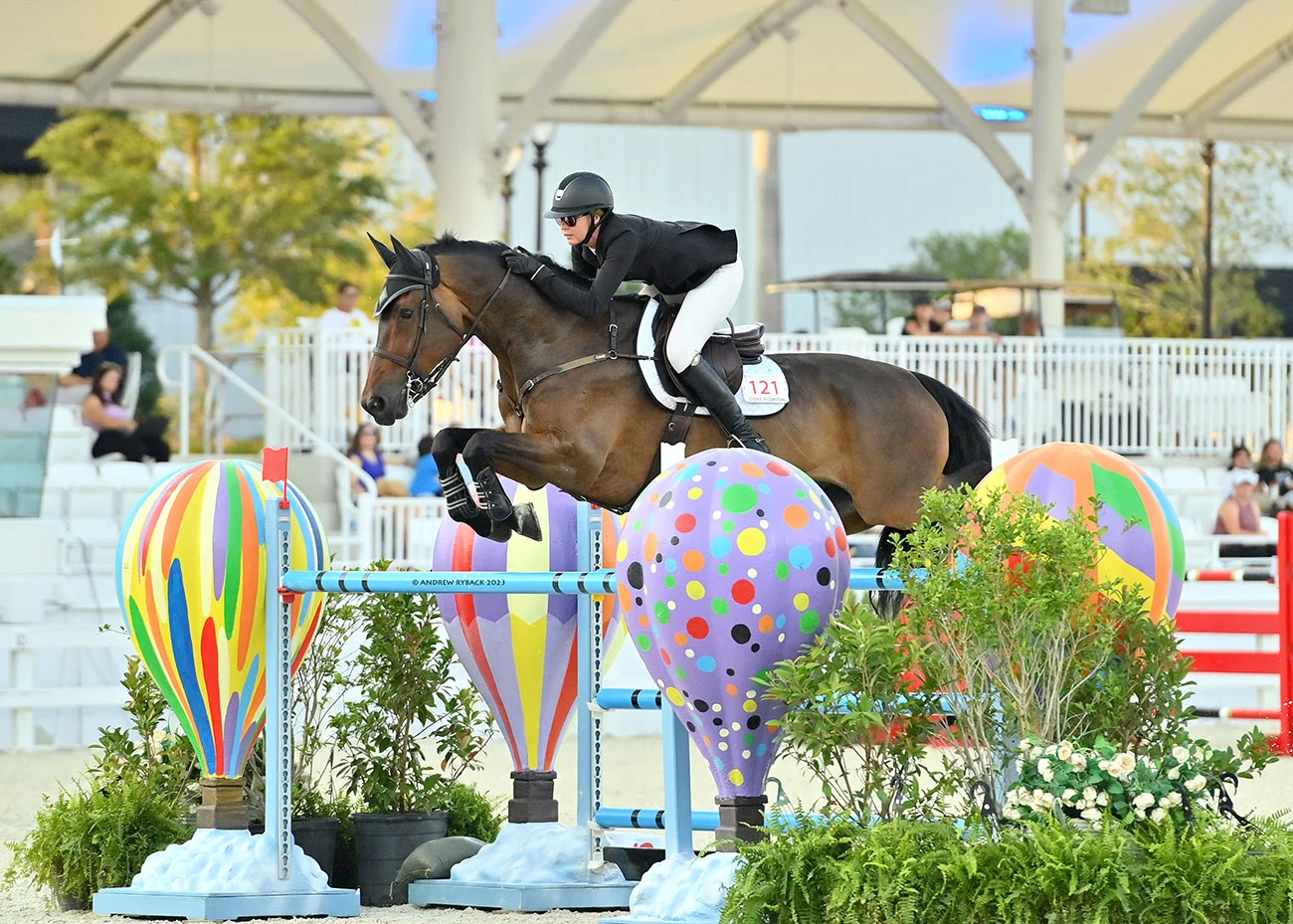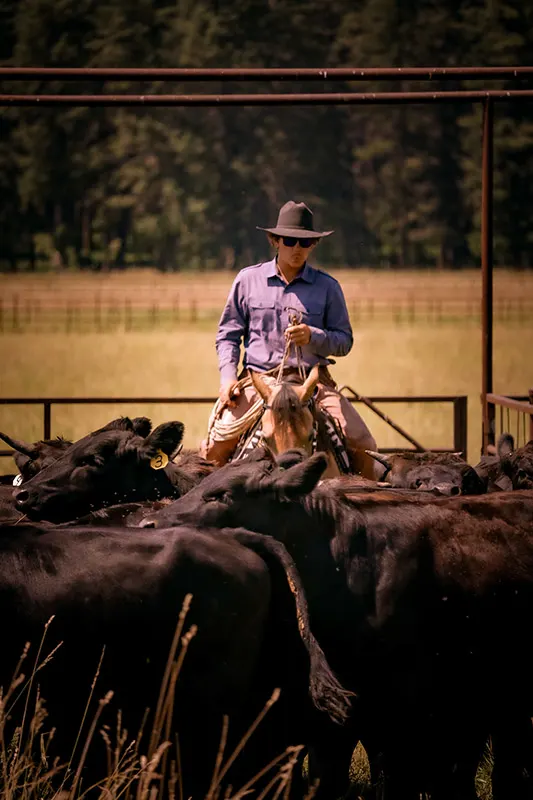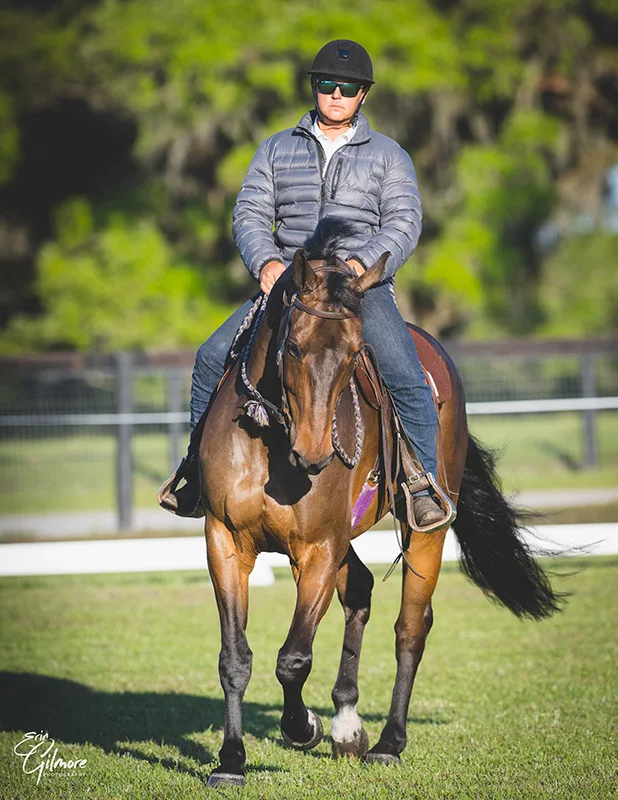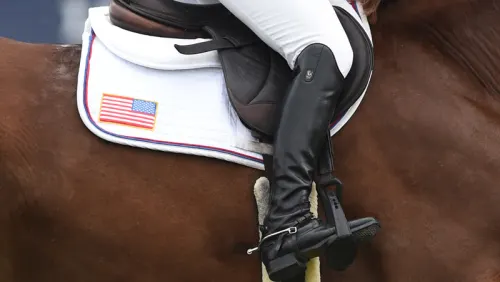Between her tall boots and his cowboy hat, they might look like an equestrian odd couple, but Hunter Holloway and Dylan Gamble’s outlook on horses is remarkably compatible. Holloway grew up on the hunter/jumper circuit while Gamble was raised on a Montana cattle ranch. Today, the young couple blends their starkly different backgrounds to develop well-rounded, agile jumpers suited to Holloway’s grand prix goals.
In part, that’s the training that has helped Eastern Jam become Holloway’s “steady Eddie,” as well as a successful grand prix competitor. Most recently, Holloway rode Eastern Jam, a 14-year-old Dutch Warmblood gelding (Lexicon—Salana, Monaco) owned by Hays Investment Corp., to the top spot in the $150,000 Florida Coast Equipment Grand Prix CSI3* on July 1 at the World Equestrian Center—Ocala (Florida).
“You know, that horse is the love of my life,” Holloway said after their victory. “He’s been a long-term partner of mine, so it always feels great when I win on him.”

Gamble isn’t jealous of the horse and rider’s partnership, which is going on eight years this fall. Holloway, who is 25, started riding “Jam” in her last year as a junior rider.
“[Jam] is the No. 1 man around,” Gamble said with a laugh. “I definitely take second place to him.”
‘If They Can Settle With The Cows, Then A Crowd Isn’t A Big Deal’
In April, a photo of Gamble schooling “Jam” in western tack at Live Oak International (Florida) went viral and raised eyebrows. But what looked out of place to onlookers—a cowboy schooling a grand prix jumper—is a normal day for Holloway’s horses.
“My boyfriend and I worked together within the barn—the whole entire operation we work together on,” Holloway said. “He grew up riding western and starting colts. The last few years, he’s integrated into my business as well.”
Holloway and Gamble met in Florida about four years ago.
Gamble, who learned his brand of horsemanship from trainer and clinician Buck Brannaman, was starting colts. Holloway took an interest in Gamble’s approach and invited him to her farm in Topeka, Kansas.
“Kansas is exactly halfway home to Montana, so I stopped in there for a little bit and started a bunch of her babies,” Gamble said. “She liked what they felt like. Not saying they were ready to go to the show pen, but there wasn’t a lot of fight with them. They were searching to get along, rather than spooking and searching to get away from things.”
By the time the two friends began dating, they already knew that they shared a vision on how their horses should go—whatever the job or the tack. They found that, by bouncing ideas off each other, the horses went better and got there faster.
“When you have two people working towards the same goal, you get there a lot quicker,” Holloway said. “So he rides all my horses. All of them will actually go in the western tack.”
ADVERTISEMENT
While Holloway thinks in terms of striding and rollbacks, and Gamble in terms of nimbly moving cows, they’ve designed a program that uses principles from both schools of thought to put strong basics on their horses.
“Really when I’m riding them, I’m thinking more about working a cow, or getting them to where I can ride with one hand so I can rope off of them,” Gamble said. “For me, the important thing is being able to do any job, no matter where we are. It’s a lot nicer riding a horse that weighs ounces instead of pounds in your hands.”
Holloway, who rarely jumps her horses except at shows, also focuses her flatwork on creating lightness.
“What I want out of my horses at the end is self-carriage—riding off the leg, light to the hand—and that goes hand-in-hand with what he’s looking for out of his horses well,” Holloway said.
The effort these two put into their horses’ flatwork means they’re much more attuned to Holloway over fences.
“Hunter’s job is a lot easier when the horse is listening instead of pulling. We’re developing the power with the lightness,” Gamble said. “In an ideal world, you don’t have to micromanage every bit of the horse. You can just focus on the track instead of having to always hold that horse up.”
The couple also sees value in creating new experiences for the horses that mimic the excitement of busy showgrounds. They develop their confidence in unfamiliar situations by tackling varied jobs. Jam won’t be transitioning to a career as a cow horse anytime soon, but Holloway admits he’s no stranger to cows.

“I have ridden Jam on cows, and he loves it,” she said with a laugh. “At my farm in Kansas my family also does cows, so I’ve trotted him through the cows and helped move a herd here and there.”
Holloway and Gamble see the value in seeking out novel experiences that prepare the horses for the intensity of competition.
“Anytime there’s an opportunity to go move some cows in a pretty low stress situation, I jump on that opportunity,” Gamble said. “That’s a lot of energy for a horse to take in. Then all of a sudden when you’re jumping in an arena with a bunch of people, that’s not so foreign as to what the cows are. If they can settle with the cows, then a crowd isn’t a big deal.”
Doing The Job Softly
When Gamble envisions the softness he wants for Holloway’s horses, he thinks of trainers like Brannaman and Ray Hunt. Their horses were known to be so relaxed, they would often fall asleep standing under saddle.
“But it takes them about a millisecond, and they have the most electric horse in the world, and then it takes even quicker to turn them off,” Gamble said. “That’s the part that I keep searching for is the turn off—being able to bring them all the way up to that high energy that you need to show and compete, and then be able to just shut them down and just have them be quiet again, mentally, physically, emotionally.”
ADVERTISEMENT
All the work the two riders put into their youngsters early on pays off in sensible horses that Holloway can trust with most jobs.
“All of my horses are horses you could go out on a trail on, you could go have fun on, you could flat out; you would never be concerned about them blowing up over something silly,” Holloway said. “They’re just well-rounded horses.”
Like the horses, the humans of the show jumping world are also becoming accustomed to unfamiliar sights. Gamble’s western saddle in the warm-up ring is now far less shocking.

“Luckily, we’ve had quite a bit of success, so the comments have gone away,” Gamble said.
When there are occasional offhand remarks about the cowboy in the jumper ring, the couple’s friends set onlookers straight.
“Some of our friends go, ‘Yeah, that cowboy right there just rode the horse that was third in World Cup Finals,’ ” he said with a laugh, referring to Pepita Con Spita, the horse Holloway rode to a podium spot at the Longines FEI Jumping World Cup Final (Nebraska) in April. “Then, they start watching the ride as opposed to what tack is on.”
And as for Gamble’s jumping career?
“If I have one or two beers in me, I think, ‘Oh, that little X right there doesn’t look so big,’ ” Gamble said. “But no, I don’t have any interest in competing.”
Gamble and Holloway are just glad that people are seeing that their unlikely blend of backgrounds is producing winning outcomes and happy horses.
“A lot of top riders are seeing the benefit of what I do, and instead of scrutinizing, they’re asking questions,” Gamble said. “That’s pretty cool to me, to see that a lot of these people, even though they’re at the top of the sport, are still searching every day.”
This article appeared in the July 24-31, 2023, issue of The Chronicle of the Horse. You can subscribe and get online access to a digital version and then enjoy a year of The Chronicle of the Horse and our lifestyle publication, Untacked. If you’re just following COTH online, you’re missing so much great unique content. Each print issue of the Chronicle is full of in-depth competition news, fascinating features, probing looks at issues within the sports of hunter/jumper, eventing and dressage, and stunning photography.














